How to Build A Patio Wall Panel
Patio wall panels can be used to build a wide variety of projects in your own backyard. These basic steps will help you learn how to build a simple wall panel either on an existing patio or on soil. Once you have the basics steps in hand you can build everything from seating walls, and outdoor rooms to ponds, fire pits and garden walls.
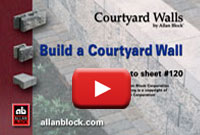
Video: How to Build a Patio Wall - On Existing Pavement

Layout the wall panel
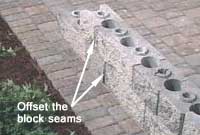
Build the first 2 courses

Build wall panel to desired height
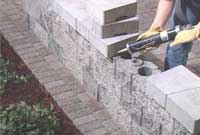
Secure wall caps with adhesive
Installing on Existing Patios or Pavement
If you will be building in an area that does not have an existing patio or pavement, see the instructions below on how to build a wall panel on soil.
Step 1: Layout
Determine the location of the wall panel. To ensure that the placement of the wall is straight and in the location desired use a string line if necessary.
Step 2: Build
Install the first two courses of block at the same time. Place 3-5 blocks on the first course, then place 3-5 blocks on the second course. Installing the first two courses at the same time will ensure that the blocks line up properly. The raised rings on the top of the blocks lock the courses together by fitting into the blocks above.
Step 3: Continue Building
Continue stacking courses of blocks in the pattern you have chosen until the desired height is achieved. Remember to offset the block seams on each course of blocks from the course below. See the Helpful Tips below for additional information.
Step 4: Finish
Finish the wall with Wall Caps. On straight sections alternate the direction of the Wall Cap, on curved walls, place the short end of the caps on the inside of the curve. Use a flexible concrete adhesive to secure each Wall Cap in place with a bead of adhesive along both sides of the raised rings and along the side of each Wall Cap.
Helpful Tips
AB Dublin - Install the same angled block one after another, to switch to the other angled AB Dublin, place an AB York block in between. See example images at bottom of page on right.
AB York - For a straight panel, rotate every other block to create a straight section. For a curved panel, place the short side of the block facing the inside of the curve.
Additional Information:
Taller walls will require some added stability. Try one of these strengthening techniques:

Video: How to Build a Patio Wall on Soil
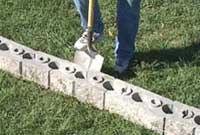
Layout the wall panel

Dig the base trench
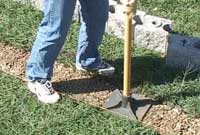
Compact the base trench
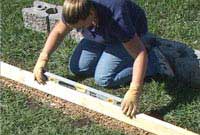
Level the base trench
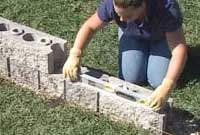
Build the first 2 courses
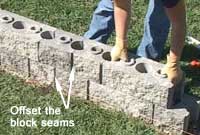
Build wall panel to desired height
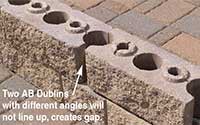
Helpful Tip - Switch to other angle by sliding AB Dublin down.

Helpful Tip - Then add in a AB York block to change angles.
How to Build A Courtyard Wall On Soil
If you will building in an area that has an existing patio or pavement, see the instructions above on how to build a wall panel on an exisiting paved surface
Step 1: Mark Your Layout
Determine the location of the wall panel and lay the first course of block to determine the shape of the wall and to establish where to dig the trench. AB Dublin, AB York or both blocks together can be used for the base course.
See building with curves or building with corners if either will be needed on your project. The AB Courtyard Collection can be used to retain two courses of soils, see retaining soil with AB Courtyard for more information.
Step 2: Build Foundation*
Mark the location of the wall with a shovel, remove the blocks and dig a level trench 3 in. deep (75 mm) and 7 in. wide (180 mm).
*Note: The soil beneath the foundation pad must be a good quality compactable material. If soft soils are encountered, they will need to be removed and replaced with additional base rock. A good foundation will ensure a stable wall for years to come.
Step 3: Fill
Place 3 in. (75 mm) of base rock in the trench and compact using a hand tamper.
Base Rock: Using the proper materials to create the base foundation for the panels is important when building on soil. We recommend using a compactible base rock material that is gravel in varying sizes of angular or smooth aggregates similar to the wall rock used in retaining walls or a road/ paver base type material.
Step 4: Level
Level the base rock. We recommend using a 2x4 and a level to ensure the entire trench is level. Make any adjustments as needed by adding or removing the base rock.
Step 5: Build
Install the first two courses of block at the same time, tamping and leveling into place. Place 3-5 blocks in the trench, level, then place 3-5 blocks on the second course. Installing the first two courses at the same time will ensure that the blocks line up properly. The raised rings on the top of the blocks lock the courses together by fitting into the blocks above.
Step 6: Continue Building
Continue stacking courses of blocks in the pattern you have chosen until the desired height is achieved. Remember to offset the block seams on each course of blocks from the course below. See the Helpful Tips below for additional information.
Step 7: Finshing
Finish the wall with Wall Caps. On straight sections alternate the direction of the Wall Cap, on curved walls, place the short end of the caps on the inside of the curve. Secure the Wall Caps in place with a bead of flexible concrete adhesive along both sides of the raised rings and along the side of each Wall Cap .
Helpful Tips
AB Dublin - Install the same angled block one after another, to switch to the other angled AB Dublin, place an AB York block in between. See example images at bottom right.
AB York - For a straight panel, rotate every other block to create a straight section. For a curved panel, place the short side of the block facing the inside of the curve.
Additional Information:
- Taller walls will require some added stability. See How-to sheet #150 Building Taller Wall Panels for more helpful construction techniques.
- If building your wall panel with posts/pillars, interlock them together for added stability. See How-to sheet #230 Interlocking Walls & Posts.